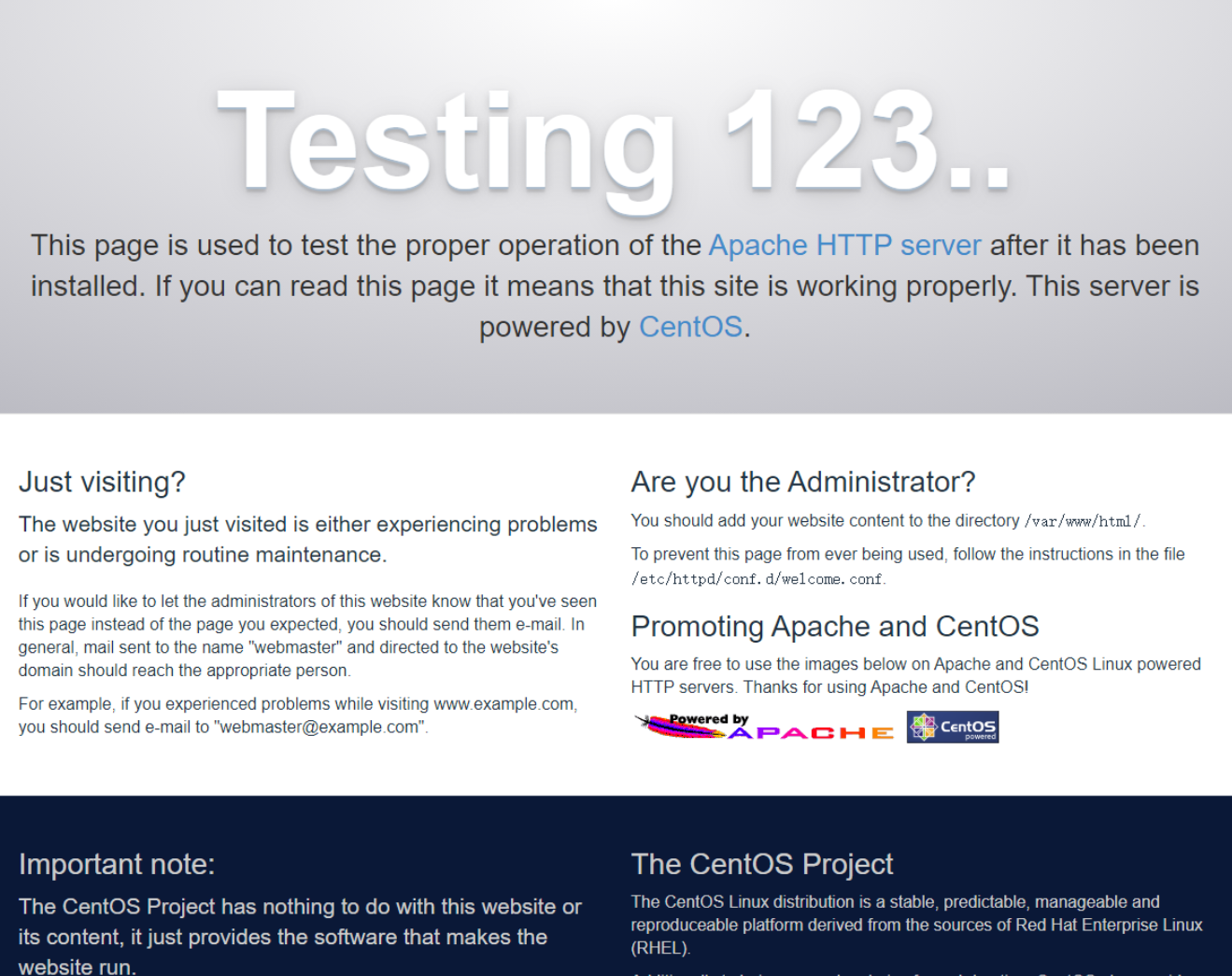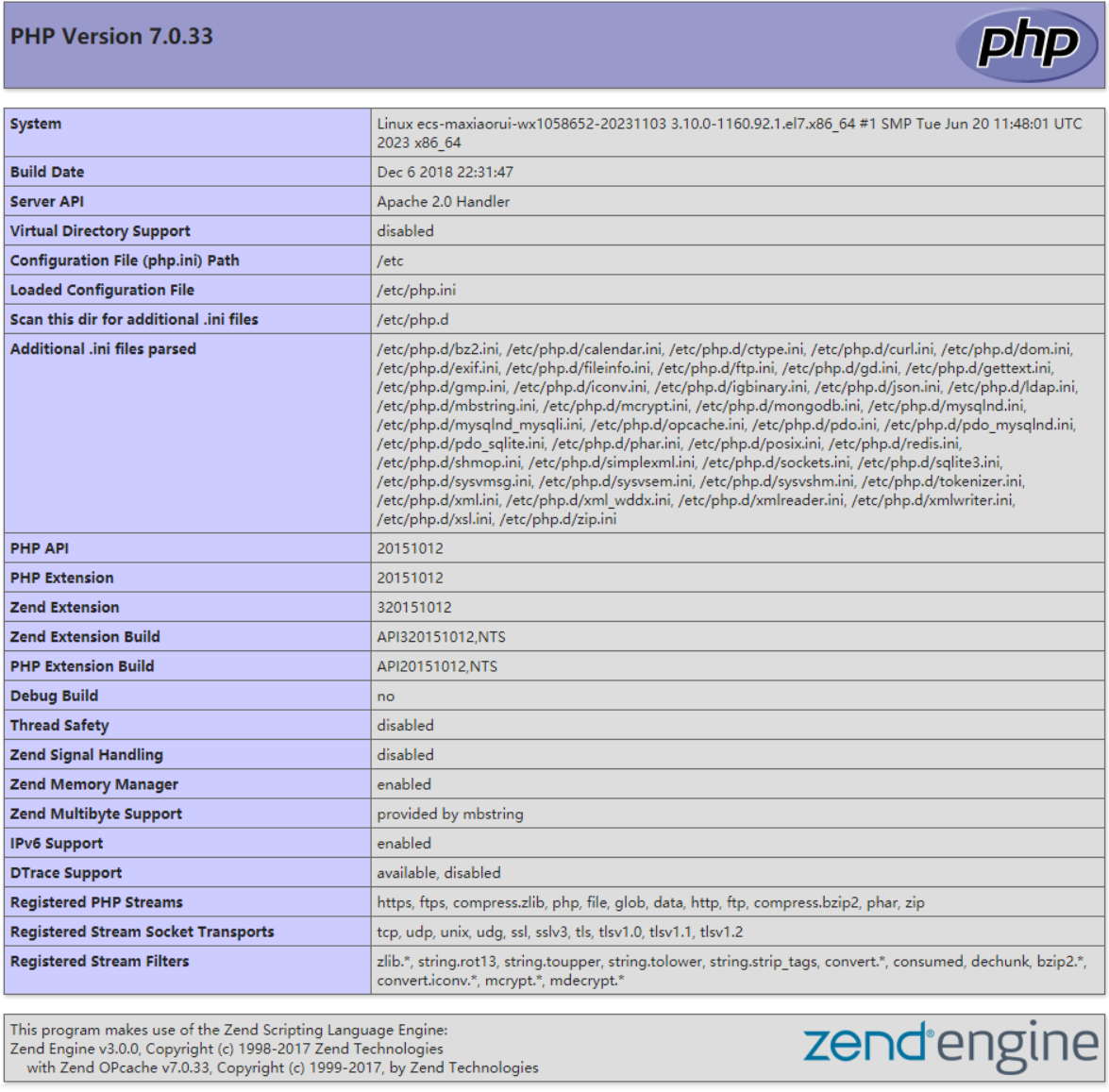简介
LAMP是由Linux、Apache、MySQL和PHP建立的web应用平台。
本文主要介绍了在天翼云上如何使用弹性云主机的Linux实例手工搭建LAMP平台的web环境。该指导具体操作以CentOS 7.8 64位操作系统为例。
前提条件
1、弹性云主机已绑定弹性公网IP。
2、弹性云主机所在安全组添加了如下表所示的安全组规则
| 方向 | 协议/应用 | 端口/范围 | 源地址 |
|---|---|---|---|
| 入方向 | HTTP(80) | 80 | 0.0.0.0/0 |
资源规划
本次实践所用的资源配置及软件版本如下表中所示。当您使用不同的硬件规格或软件版本时,本指导中的命令及参数可能会发生改变,需要您根据实际情况进行调整。
| 资源 | 资源说明 | 成本说明 |
|---|---|---|
| 弹性云主机 | 计费模式:按需计费 规格:c7n.large.2 镜像:CentOS 7.8 64bit 系统盘:40G 弹性公网IP:自动分配 公网带宽:按流量计费 带宽大小:5 Mbit/s |
ECS涉及以下几项费用: · 云主机 · 云硬盘 · 弹性公网IP |
| Apache | 是一个开放源码的Web服务器。 | 免费 |
| MySQL | 是一款开源的关系数据库软件。获取方式:http://dev.mysql.com/get/mysql57-community-release-el7-10.noarch.rpm | 免费 |
| PHP | 是一款开源软件,用于Web开发。获取方式:https://mirror.webtatic.com/yum/el7/epel-release.rpmhttps://mirror.webtatic.com/yum/el7/webtatic-release.rpm | 免费 |
操作步骤
1、安装Apache。
a.登录弹性云主机。
b.使用root用户执行以下命令更新软件包,并安装Apache。
yum -y updateyum -y install httpd
c.执行以下命令,验证Apache的安装版本。
httpd -v
回显如下类似信息:
Server version:Apache/2.4.6 (CentOS)Server built: May 30 2023 14:01:11
d.依次执行以下命令,启动Apache服务并设置开机自启动。
systemctl start httpd
systemctl enable httpd
e.使用浏览器访问“http://服务器IP地址”,显示如下页面,说明Apache安装成功。

2、安装MySQL。
a.依次执行以下命令,安装MySQL。
wget -i -c http://dev.mysql.com/get/mysql57-community-release-el7-10.noarch.rpm
yum -y install mysql57-community-release-el7-10.noarch.rpm
yum -y install mysql-community-server --nogpgcheck
b.执行以下命令,验证MySQL的安装版本。
mysql -V
回显如下类似信息:
mysql Ver 14.14 Distrib 5.7.44, for Linux (x86_64) using EditLine wrapper
c.依次执行以下命令,启动MySQL服务并设置开机自启动。
systemctl start mysqld
systemctl enable mysqld
d.查看MySQL运行状态。
systemctl status mysqld.service
[root@ecs-adc3 ~]# systemctl status mysqld.service
● mysqld.service - MySQL Server
Loaded: loaded (/usr/lib/systemd/system/mysqld.service; enabled; vendor preset: disabled)
Active: active (running) since Tue 2023-10-31 19:33:40 CST; 36s ago
Docs: man:mysqld(8)
http://dev.mysql.com/doc/refman/en/using-systemd.html
Main PID: 7916 (mysqld)
CGroup: /system.slice/mysqld.service
└─7916 /usr/sbin/mysqld --daemonize --pid-file=/var/run/mysqld/mysqld.pid
Aug 16 19:33:35 ecs-adc3 systemd[1]: Starting MySQL Server...
Aug 16 19:33:40 ecs-adc3 systemd[1]: Started MySQL Server.
e.执行以下命令,获取安装MySQL时自动设置的root用户密码。
grep 'temporary password' /var/log/mysqld.log
回显如下类似信息。
2023-10-31T11:53:08.691748Z 1 [Note] A temporary password is generated for root@localhost: 2YY?3uHUA?Ys
f.执行以下命令,并按照回显提示信息进行操作,加固MySQL。
mysql_secure_installation
Securing the MySQL server deployment.
Enter password for user root: #输入上一步骤中获取的安装MySQL时自动设置的root用户密码
The existing password for the user account root has expired. Please set a new password.
New password: #设置新的root用户密码
Re-enter new password: #再次输入密码
The 'validate_password' plugin is installed on the server.
The subsequent steps will run with the existing configuration of the plugin.
Using existing password for root.
Estimated strength of the password: 100
Change the password for root ? ((Press y|Y for Yes, any other key for No) : N #是否更改root用户密码,输入N
... skipping.
By default, a MySQL installation has an anonymous user,
allowing anyone to log into MySQL without having to have
a user account created for them. This is intended only for
testing, and to make the installation go a bit smoother.
You should remove them before moving into a production
environment.
Remove anonymous users? (Press y|Y for Yes, any other key for No) : Y #是否删除匿名用户,输入Y
Success.
Normally, root should only be allowed to connect from 'localhost'. This ensures that someone cannot guess at the root password from the network.
Disallow root login remotely? (Press y|Y for Yes, any other key for No) : Y #禁止root远程登录,输入Y
Success.
By default, MySQL comes with a database named 'test' that anyone can access. This is also intended only for testing, and should be removed before moving into a production environment.
Remove test database and access to it? (Press y|Y for Yes, any other key for No) : Y #是否删除test库和对它的访问权限,输入Y
- Dropping test database...
Success.
- Removing privileges on test database...
Success.
Reloading the privilege tables will ensure that all changes
made so far will take effect immediately.
Reload privilege tables now? (Press y|Y for Yes, any other key for No) : Y #是否重新加载授权表,输入Y
Success.
All done!
3、安装PHP。
a.依次执行以下命令,安装PHP 7和一些所需的PHP扩展。
rpm -Uvh https://mirror.webtatic.com/yum/el7/epel-release.rpm
rpm -Uvh https://mirror.webtatic.com/yum/el7/webtatic-release.rpm
yum -y install php70w-devel php70w.x86_64 php70w-cli.x86_64 php70w-common.x86_64 php70w-gd.x86_64 php70w-ldap.x86_64 php70w-mbstring.x86_64 php70w-mcrypt.x86_64 php70w-pdo.x86_64 php70w-mysqlnd php70w-fpm php70w-opcache php70w-pecl-redis php70w-pecl-mongodb
b.执行以下命令,验证PHP的安装版本。
php -v
回显如下类似信息:
PHP 7.0.33 (cli) (built: Dec 6 2018 22:30:44) ( NTS )
Copyright (c) 1997-2017 The PHP Group
Zend Engine v3.0.0, Copyright (c) 1998-2017 Zend Technologies
c.执行以下命令,启动PHP服务并设置开机自启动。
systemctl start php-fpm
systemctl enable php-fpm
4、浏览器访问测试。
a.在/var/www/html/目录下创建“info.php”的测试页面。
1.执行以下命令创建并打开“info.php”的测试文件。
vim /var/www/html/info.php
2.按i键进入编辑模式。
3.修改打开的“info.php”文件,将如下内容写入文件。
<?php
phpinfo();
?>
4.按Esc键退出编辑模式,并输入:wq保存后退出。
b.执行以下命令,重启Apache服务。
systemctl restart httpd
c.使用浏览器访问“http://服务器IP地址/info.php”,显示如下页面,说明环境搭建成功。

